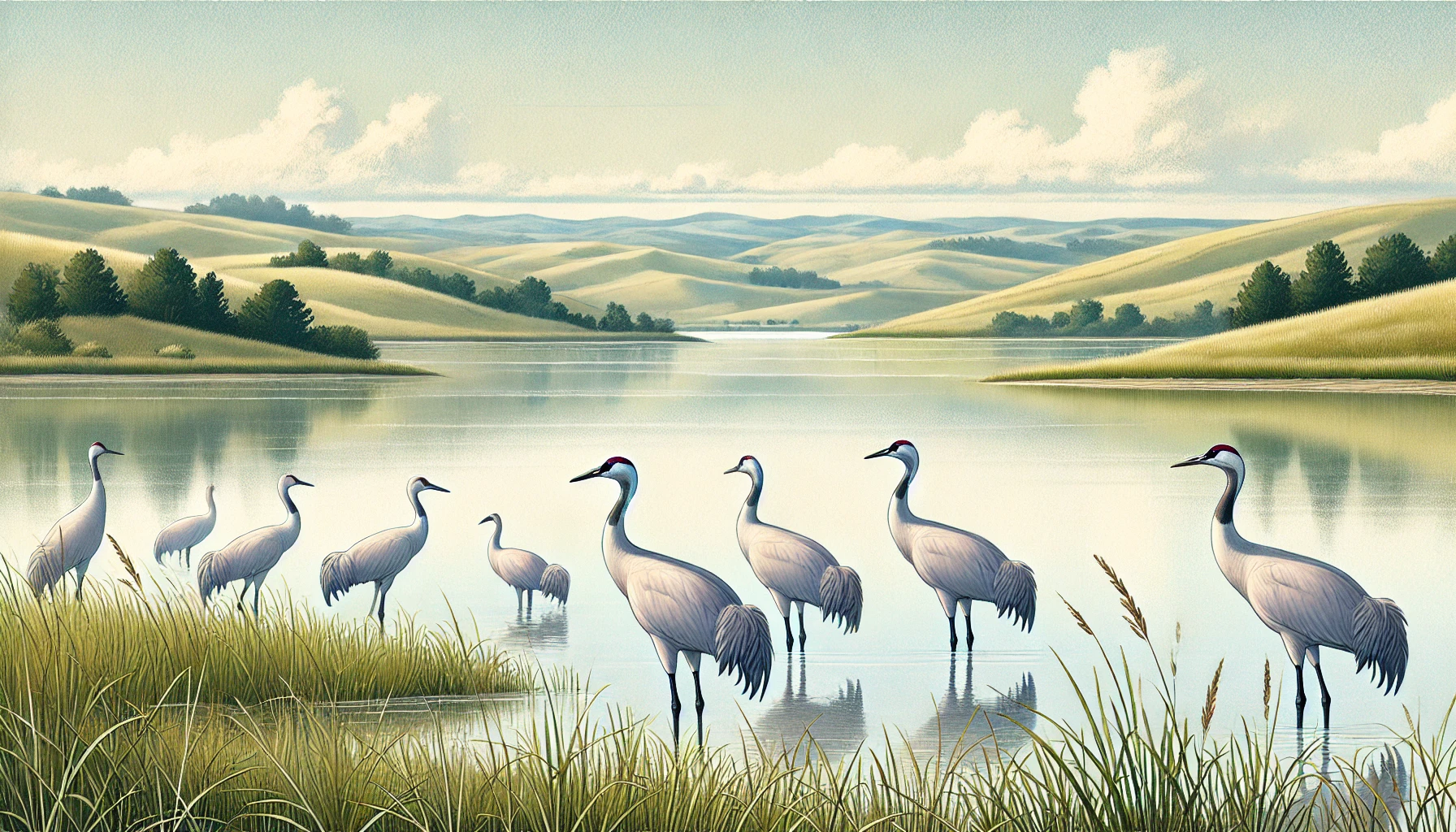Rainwater Basin Water Management

Traveling through Nebraska, a state known for its vast grasslands and diverse wildlife, one cannot overlook the importance of the Rainwater Basin, a complex network of wetlands and waterways that support a wide range of ecosystems. The Rainwater Basin, located in south-central Nebraska, covers an area of approximately 22,700 square miles and encompasses 18 counties. As a vital component of the state's natural heritage, effective Rainwater Basin water management is crucial for maintaining the health and biodiversity of these ecosystems.
The Rainwater Basin is a crucial stopover point for millions of migratory birds, including the endangered Whooping Crane and the Sandhill Crane, which congregate in massive flocks at locations such as Rowe Sanctuary in Kearney County. These birds, along with numerous other species of waterfowl, shorebirds, and songbirds, depend on the Rainwater Basin's wetlands and waterways for food, shelter, and breeding grounds. However, the delicate balance of this ecosystem is threatened by a range of factors, including habitat loss, climate change, and the impacts of human activities such as agriculture and urbanization.
To address these challenges, the Rainwater Basin Joint Venture was established in 1999, a collaborative effort between state and federal agencies, private landowners, and non-profit organizations. The Joint Venture aims to conserve and restore wetlands and grasslands in the Rainwater Basin, while also promoting sustainable land-use practices and supporting local communities. Key initiatives include the restoration of wetlands and grasslands, the conservation of aquatic habitats, and the implementation of best management practices for agriculture and other human activities.
One exemplary model of Rainwater Basin water management is the Platte River Recovery Implementation Program, which aims to recover the Platte River, a vital component of the Rainwater Basin ecosystem. The program, a collaborative effort between the states of Nebraska, Colorado, and Wyoming, along with the U.S. Fish and Wildlife Service, seeks to restore habitat for endangered species, improve water flows, and reduce the impacts of human activities on the river. Specific projects include the restoration of wetlands and sandbars along the Platte River, the construction of canal bypasses to reduce water diversion, and the implementation of conservation measures on private lands.
Another notable example is the work of the Nature Conservancy's Platte River Program, which has conserved over 20,000 acres of land in the Rainwater Basin, including critical habitats for Sandhill Cranes and other migratory birds. The program works with private landowners to promote sustainable land-use practices, such as restoring wetlands and grasslands, reducing water consumption, and implementing conservation agriculture practices.
Effective Rainwater Basin water management requires a comprehensive and multi-faceted approach, involving the collaboration of government agencies, private landowners, and non-profit organizations. It also requires a deep understanding of the complex interactions between water, land, and ecosystems in the basin. By working together and leveraging the expertise and resources of various stakeholders, it is possible to conserve and restore the Rainwater Basin's ecosystems, while also supporting the local economy and promoting the well-being of both people and wildlife.
Moreover, the benefits of effective Rainwater Basin water management extend beyond the immediate ecosystem to have far-reaching impacts on regional and national scales. For example, restored wetlands and grasslands in the Rainwater Basin can help mitigate the impacts of climate change by sequestering carbon, while also providing critical habitats for migratory birds and other wildlife. Furthermore, sustainable land-use practices in the basin can help maintain the productivity of agricultural systems, ensuring food security and economic stability for local communities.
In conclusion, Rainwater Basin water management is a critical component of maintaining the health and biodiversity of ecosystems in south-central Nebraska. Effective management requires a comprehensive approach that balances human activities with ecosystem conservation, and relies on the collaboration of various stakeholders.
The Rainwater Basin is a crucial stopover point for millions of migratory birds, including the endangered Whooping Crane and the Sandhill Crane, which congregate in massive flocks at locations such as Rowe Sanctuary in Kearney County. These birds, along with numerous other species of waterfowl, shorebirds, and songbirds, depend on the Rainwater Basin's wetlands and waterways for food, shelter, and breeding grounds. However, the delicate balance of this ecosystem is threatened by a range of factors, including habitat loss, climate change, and the impacts of human activities such as agriculture and urbanization.
To address these challenges, the Rainwater Basin Joint Venture was established in 1999, a collaborative effort between state and federal agencies, private landowners, and non-profit organizations. The Joint Venture aims to conserve and restore wetlands and grasslands in the Rainwater Basin, while also promoting sustainable land-use practices and supporting local communities. Key initiatives include the restoration of wetlands and grasslands, the conservation of aquatic habitats, and the implementation of best management practices for agriculture and other human activities.
One exemplary model of Rainwater Basin water management is the Platte River Recovery Implementation Program, which aims to recover the Platte River, a vital component of the Rainwater Basin ecosystem. The program, a collaborative effort between the states of Nebraska, Colorado, and Wyoming, along with the U.S. Fish and Wildlife Service, seeks to restore habitat for endangered species, improve water flows, and reduce the impacts of human activities on the river. Specific projects include the restoration of wetlands and sandbars along the Platte River, the construction of canal bypasses to reduce water diversion, and the implementation of conservation measures on private lands.
Another notable example is the work of the Nature Conservancy's Platte River Program, which has conserved over 20,000 acres of land in the Rainwater Basin, including critical habitats for Sandhill Cranes and other migratory birds. The program works with private landowners to promote sustainable land-use practices, such as restoring wetlands and grasslands, reducing water consumption, and implementing conservation agriculture practices.
Effective Rainwater Basin water management requires a comprehensive and multi-faceted approach, involving the collaboration of government agencies, private landowners, and non-profit organizations. It also requires a deep understanding of the complex interactions between water, land, and ecosystems in the basin. By working together and leveraging the expertise and resources of various stakeholders, it is possible to conserve and restore the Rainwater Basin's ecosystems, while also supporting the local economy and promoting the well-being of both people and wildlife.
Moreover, the benefits of effective Rainwater Basin water management extend beyond the immediate ecosystem to have far-reaching impacts on regional and national scales. For example, restored wetlands and grasslands in the Rainwater Basin can help mitigate the impacts of climate change by sequestering carbon, while also providing critical habitats for migratory birds and other wildlife. Furthermore, sustainable land-use practices in the basin can help maintain the productivity of agricultural systems, ensuring food security and economic stability for local communities.
In conclusion, Rainwater Basin water management is a critical component of maintaining the health and biodiversity of ecosystems in south-central Nebraska. Effective management requires a comprehensive approach that balances human activities with ecosystem conservation, and relies on the collaboration of various stakeholders.
